PGDM Batch 2019-2021 Term V Project: WFH HR Metrics and Analytics
VerifiedAdded on 2021/02/03
|18
|5356
|46
Project
AI Summary
This project, conducted by PGDM students, delves into the multifaceted aspects of working from home (WFH) and its implications on human resource management. It begins with an introduction defining WFH and outlining its advantages, such as flexible schedules and reduced commute times, alongside disadvantages like willpower issues and social isolation. A comprehensive literature review explores the history of WFH, employee motivation, and performance levels, drawing on various research studies. The project's objective is to analyze the key HR metrics related to WFH. The methodology involves a questionnaire-based survey, the questions from which are detailed in the document, followed by data analysis to draw conclusions. The findings highlight interesting facts and the impact of WFH on employee productivity, engagement, and well-being. The project also acknowledges limitations and provides additional insights, culminating in a detailed analysis of WFH's effects on HR practices.
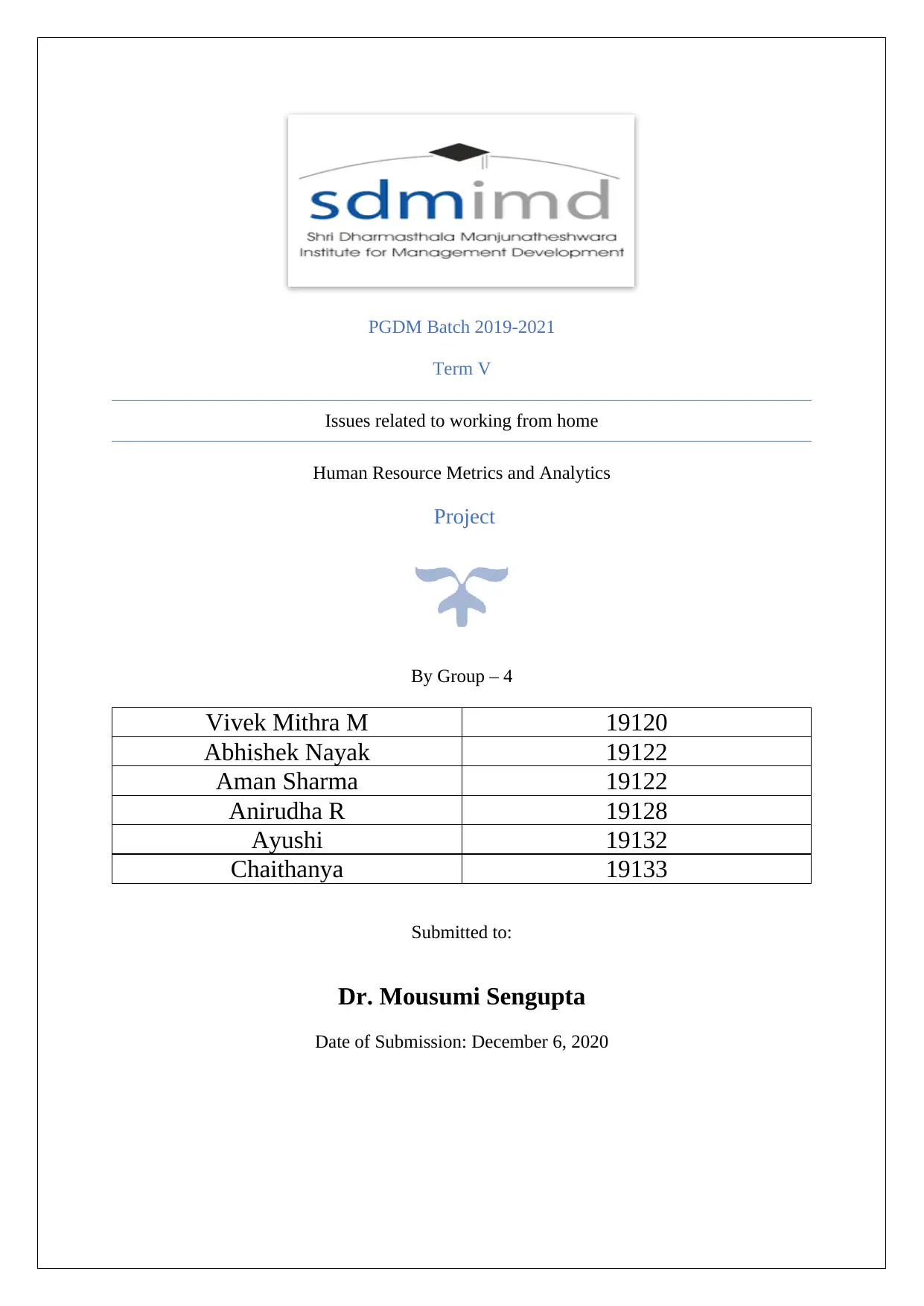
PGDM Batch 2019-2021
Term V
Issues related to working from home
Human Resource Metrics and Analytics
Project
By Group – 4
Vivek Mithra M 19120
Abhishek Nayak 19122
Aman Sharma 19122
Anirudha R 19128
Ayushi 19132
Chaithanya 19133
Submitted to:
Dr. Mousumi Sengupta
Date of Submission: December 6, 2020
Term V
Issues related to working from home
Human Resource Metrics and Analytics
Project
By Group – 4
Vivek Mithra M 19120
Abhishek Nayak 19122
Aman Sharma 19122
Anirudha R 19128
Ayushi 19132
Chaithanya 19133
Submitted to:
Dr. Mousumi Sengupta
Date of Submission: December 6, 2020
Paraphrase This Document
Need a fresh take? Get an instant paraphrase of this document with our AI Paraphraser
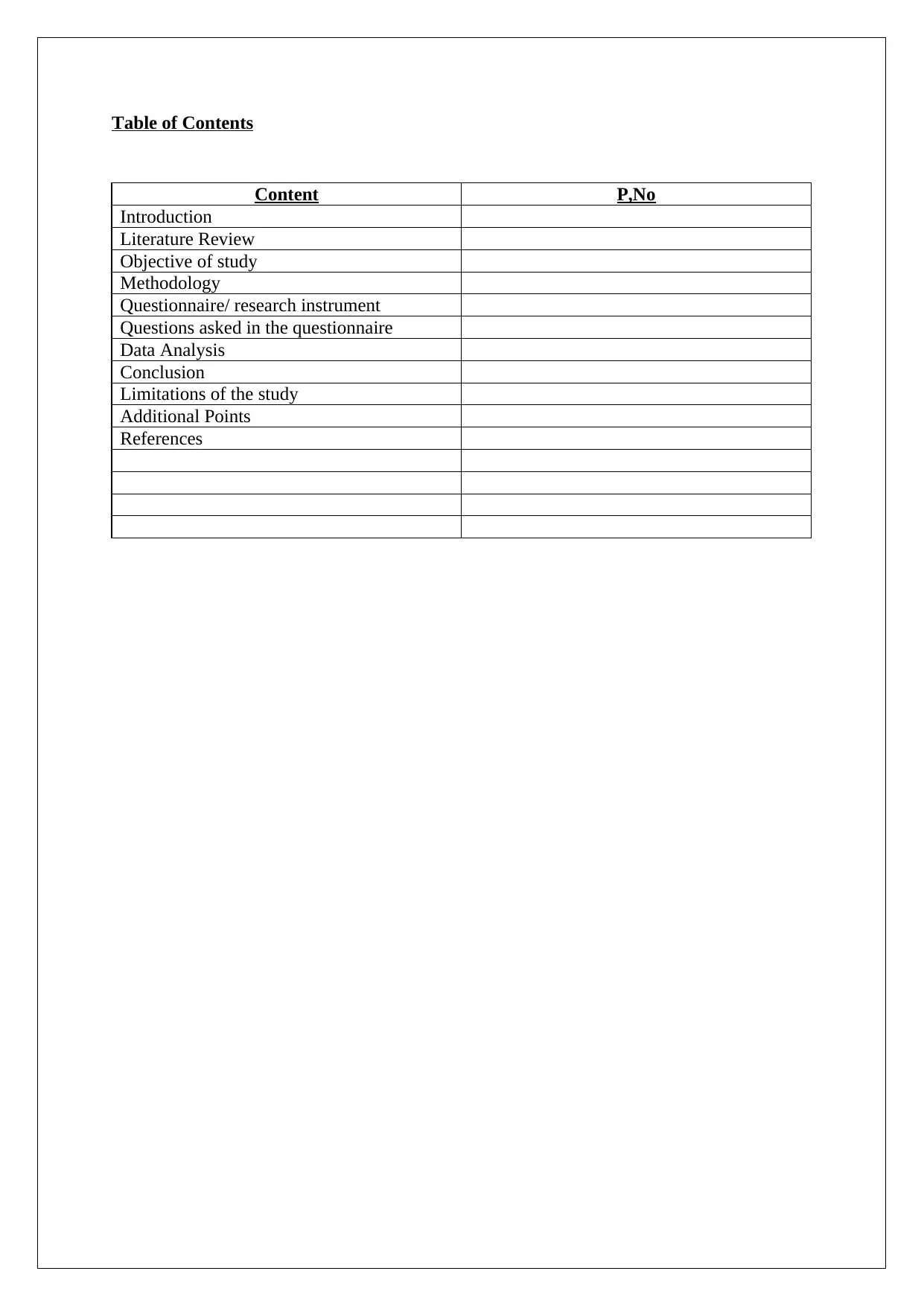
Table of Contents
Content P,No
Introduction
Literature Review
Objective of study
Methodology
Questionnaire/ research instrument
Questions asked in the questionnaire
Data Analysis
Conclusion
Limitations of the study
Additional Points
References
Content P,No
Introduction
Literature Review
Objective of study
Methodology
Questionnaire/ research instrument
Questions asked in the questionnaire
Data Analysis
Conclusion
Limitations of the study
Additional Points
References
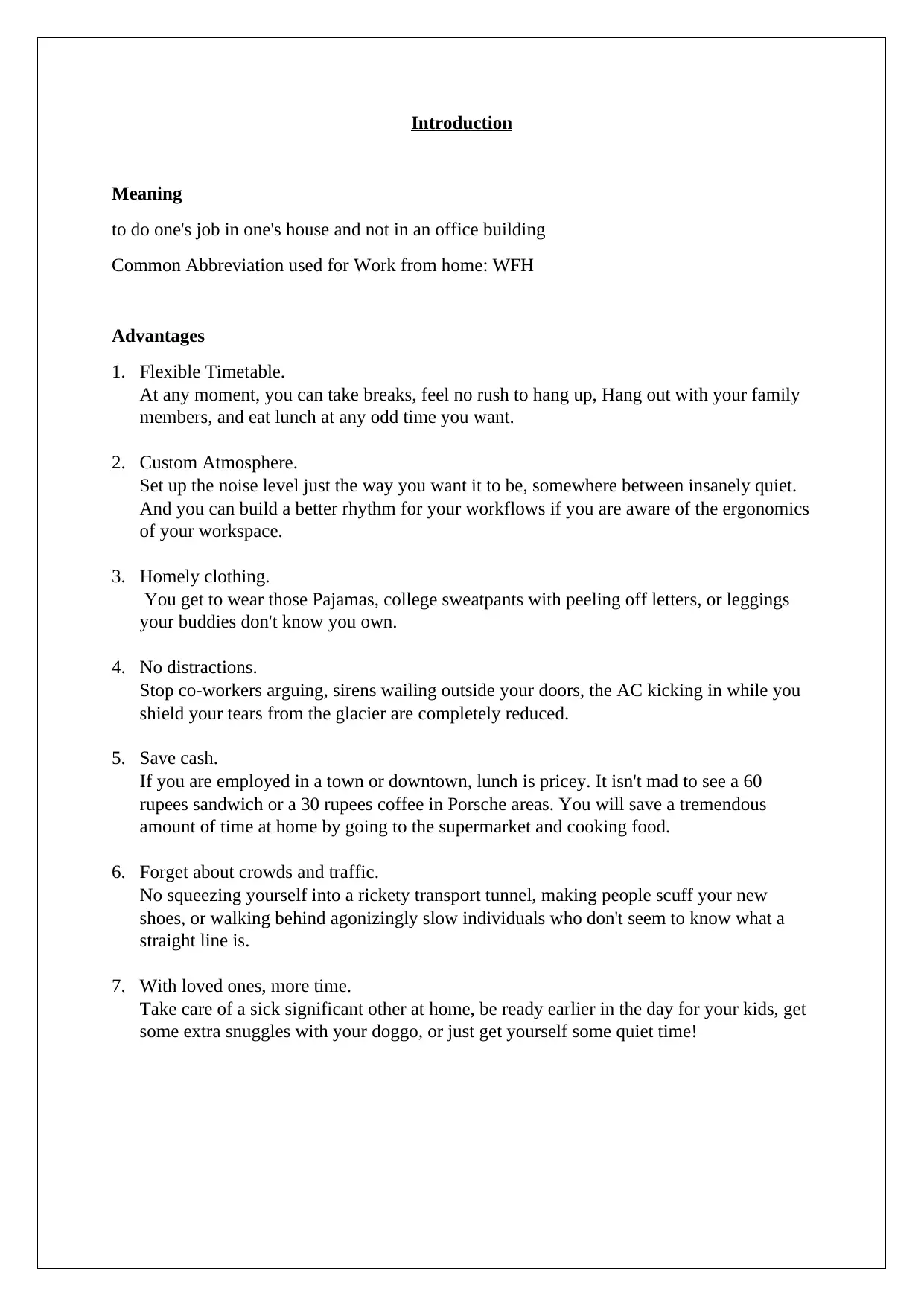
Introduction
Meaning
to do one's job in one's house and not in an office building
Common Abbreviation used for Work from home: WFH
Advantages
1. Flexible Timetable.
At any moment, you can take breaks, feel no rush to hang up, Hang out with your family
members, and eat lunch at any odd time you want.
2. Custom Atmosphere.
Set up the noise level just the way you want it to be, somewhere between insanely quiet.
And you can build a better rhythm for your workflows if you are aware of the ergonomics
of your workspace.
3. Homely clothing.
You get to wear those Pajamas, college sweatpants with peeling off letters, or leggings
your buddies don't know you own.
4. No distractions.
Stop co-workers arguing, sirens wailing outside your doors, the AC kicking in while you
shield your tears from the glacier are completely reduced.
5. Save cash.
If you are employed in a town or downtown, lunch is pricey. It isn't mad to see a 60
rupees sandwich or a 30 rupees coffee in Porsche areas. You will save a tremendous
amount of time at home by going to the supermarket and cooking food.
6. Forget about crowds and traffic.
No squeezing yourself into a rickety transport tunnel, making people scuff your new
shoes, or walking behind agonizingly slow individuals who don't seem to know what a
straight line is.
7. With loved ones, more time.
Take care of a sick significant other at home, be ready earlier in the day for your kids, get
some extra snuggles with your doggo, or just get yourself some quiet time!
Meaning
to do one's job in one's house and not in an office building
Common Abbreviation used for Work from home: WFH
Advantages
1. Flexible Timetable.
At any moment, you can take breaks, feel no rush to hang up, Hang out with your family
members, and eat lunch at any odd time you want.
2. Custom Atmosphere.
Set up the noise level just the way you want it to be, somewhere between insanely quiet.
And you can build a better rhythm for your workflows if you are aware of the ergonomics
of your workspace.
3. Homely clothing.
You get to wear those Pajamas, college sweatpants with peeling off letters, or leggings
your buddies don't know you own.
4. No distractions.
Stop co-workers arguing, sirens wailing outside your doors, the AC kicking in while you
shield your tears from the glacier are completely reduced.
5. Save cash.
If you are employed in a town or downtown, lunch is pricey. It isn't mad to see a 60
rupees sandwich or a 30 rupees coffee in Porsche areas. You will save a tremendous
amount of time at home by going to the supermarket and cooking food.
6. Forget about crowds and traffic.
No squeezing yourself into a rickety transport tunnel, making people scuff your new
shoes, or walking behind agonizingly slow individuals who don't seem to know what a
straight line is.
7. With loved ones, more time.
Take care of a sick significant other at home, be ready earlier in the day for your kids, get
some extra snuggles with your doggo, or just get yourself some quiet time!
⊘ This is a preview!⊘
Do you want full access?
Subscribe today to unlock all pages.

Trusted by 1+ million students worldwide
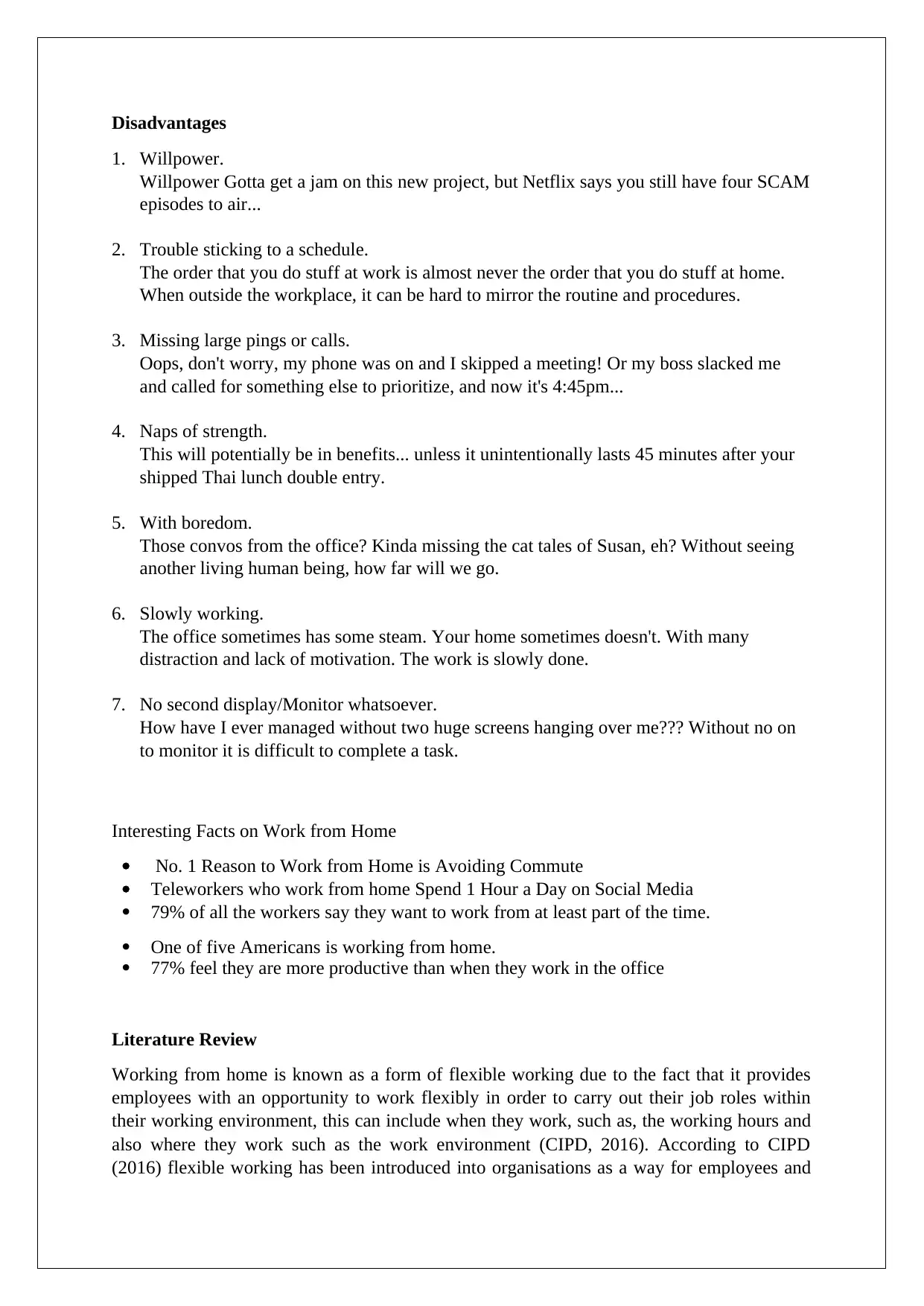
Disadvantages
1. Willpower.
Willpower Gotta get a jam on this new project, but Netflix says you still have four SCAM
episodes to air...
2. Trouble sticking to a schedule.
The order that you do stuff at work is almost never the order that you do stuff at home.
When outside the workplace, it can be hard to mirror the routine and procedures.
3. Missing large pings or calls.
Oops, don't worry, my phone was on and I skipped a meeting! Or my boss slacked me
and called for something else to prioritize, and now it's 4:45pm...
4. Naps of strength.
This will potentially be in benefits... unless it unintentionally lasts 45 minutes after your
shipped Thai lunch double entry.
5. With boredom.
Those convos from the office? Kinda missing the cat tales of Susan, eh? Without seeing
another living human being, how far will we go.
6. Slowly working.
The office sometimes has some steam. Your home sometimes doesn't. With many
distraction and lack of motivation. The work is slowly done.
7. No second display/Monitor whatsoever.
How have I ever managed without two huge screens hanging over me??? Without no on
to monitor it is difficult to complete a task.
Interesting Facts on Work from Home
No. 1 Reason to Work from Home is Avoiding Commute
Teleworkers who work from home Spend 1 Hour a Day on Social Media
79% of all the workers say they want to work from at least part of the time.
One of five Americans is working from home.
77% feel they are more productive than when they work in the office
Literature Review
Working from home is known as a form of flexible working due to the fact that it provides
employees with an opportunity to work flexibly in order to carry out their job roles within
their working environment, this can include when they work, such as, the working hours and
also where they work such as the work environment (CIPD, 2016). According to CIPD
(2016) flexible working has been introduced into organisations as a way for employees and
1. Willpower.
Willpower Gotta get a jam on this new project, but Netflix says you still have four SCAM
episodes to air...
2. Trouble sticking to a schedule.
The order that you do stuff at work is almost never the order that you do stuff at home.
When outside the workplace, it can be hard to mirror the routine and procedures.
3. Missing large pings or calls.
Oops, don't worry, my phone was on and I skipped a meeting! Or my boss slacked me
and called for something else to prioritize, and now it's 4:45pm...
4. Naps of strength.
This will potentially be in benefits... unless it unintentionally lasts 45 minutes after your
shipped Thai lunch double entry.
5. With boredom.
Those convos from the office? Kinda missing the cat tales of Susan, eh? Without seeing
another living human being, how far will we go.
6. Slowly working.
The office sometimes has some steam. Your home sometimes doesn't. With many
distraction and lack of motivation. The work is slowly done.
7. No second display/Monitor whatsoever.
How have I ever managed without two huge screens hanging over me??? Without no on
to monitor it is difficult to complete a task.
Interesting Facts on Work from Home
No. 1 Reason to Work from Home is Avoiding Commute
Teleworkers who work from home Spend 1 Hour a Day on Social Media
79% of all the workers say they want to work from at least part of the time.
One of five Americans is working from home.
77% feel they are more productive than when they work in the office
Literature Review
Working from home is known as a form of flexible working due to the fact that it provides
employees with an opportunity to work flexibly in order to carry out their job roles within
their working environment, this can include when they work, such as, the working hours and
also where they work such as the work environment (CIPD, 2016). According to CIPD
(2016) flexible working has been introduced into organisations as a way for employees and
Paraphrase This Document
Need a fresh take? Get an instant paraphrase of this document with our AI Paraphraser
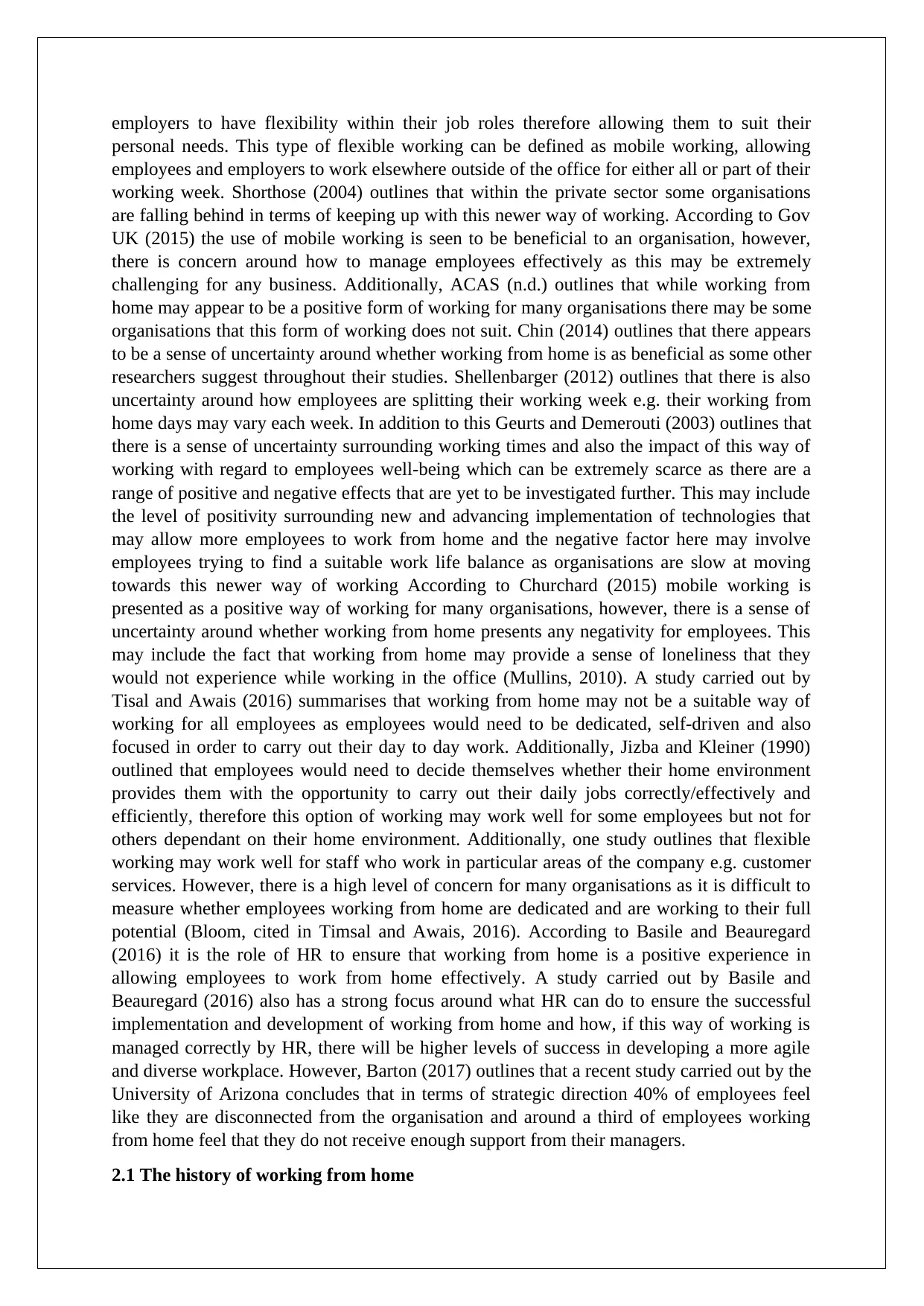
employers to have flexibility within their job roles therefore allowing them to suit their
personal needs. This type of flexible working can be defined as mobile working, allowing
employees and employers to work elsewhere outside of the office for either all or part of their
working week. Shorthose (2004) outlines that within the private sector some organisations
are falling behind in terms of keeping up with this newer way of working. According to Gov
UK (2015) the use of mobile working is seen to be beneficial to an organisation, however,
there is concern around how to manage employees effectively as this may be extremely
challenging for any business. Additionally, ACAS (n.d.) outlines that while working from
home may appear to be a positive form of working for many organisations there may be some
organisations that this form of working does not suit. Chin (2014) outlines that there appears
to be a sense of uncertainty around whether working from home is as beneficial as some other
researchers suggest throughout their studies. Shellenbarger (2012) outlines that there is also
uncertainty around how employees are splitting their working week e.g. their working from
home days may vary each week. In addition to this Geurts and Demerouti (2003) outlines that
there is a sense of uncertainty surrounding working times and also the impact of this way of
working with regard to employees well-being which can be extremely scarce as there are a
range of positive and negative effects that are yet to be investigated further. This may include
the level of positivity surrounding new and advancing implementation of technologies that
may allow more employees to work from home and the negative factor here may involve
employees trying to find a suitable work life balance as organisations are slow at moving
towards this newer way of working According to Churchard (2015) mobile working is
presented as a positive way of working for many organisations, however, there is a sense of
uncertainty around whether working from home presents any negativity for employees. This
may include the fact that working from home may provide a sense of loneliness that they
would not experience while working in the office (Mullins, 2010). A study carried out by
Tisal and Awais (2016) summarises that working from home may not be a suitable way of
working for all employees as employees would need to be dedicated, self-driven and also
focused in order to carry out their day to day work. Additionally, Jizba and Kleiner (1990)
outlined that employees would need to decide themselves whether their home environment
provides them with the opportunity to carry out their daily jobs correctly/effectively and
efficiently, therefore this option of working may work well for some employees but not for
others dependant on their home environment. Additionally, one study outlines that flexible
working may work well for staff who work in particular areas of the company e.g. customer
services. However, there is a high level of concern for many organisations as it is difficult to
measure whether employees working from home are dedicated and are working to their full
potential (Bloom, cited in Timsal and Awais, 2016). According to Basile and Beauregard
(2016) it is the role of HR to ensure that working from home is a positive experience in
allowing employees to work from home effectively. A study carried out by Basile and
Beauregard (2016) also has a strong focus around what HR can do to ensure the successful
implementation and development of working from home and how, if this way of working is
managed correctly by HR, there will be higher levels of success in developing a more agile
and diverse workplace. However, Barton (2017) outlines that a recent study carried out by the
University of Arizona concludes that in terms of strategic direction 40% of employees feel
like they are disconnected from the organisation and around a third of employees working
from home feel that they do not receive enough support from their managers.
2.1 The history of working from home
personal needs. This type of flexible working can be defined as mobile working, allowing
employees and employers to work elsewhere outside of the office for either all or part of their
working week. Shorthose (2004) outlines that within the private sector some organisations
are falling behind in terms of keeping up with this newer way of working. According to Gov
UK (2015) the use of mobile working is seen to be beneficial to an organisation, however,
there is concern around how to manage employees effectively as this may be extremely
challenging for any business. Additionally, ACAS (n.d.) outlines that while working from
home may appear to be a positive form of working for many organisations there may be some
organisations that this form of working does not suit. Chin (2014) outlines that there appears
to be a sense of uncertainty around whether working from home is as beneficial as some other
researchers suggest throughout their studies. Shellenbarger (2012) outlines that there is also
uncertainty around how employees are splitting their working week e.g. their working from
home days may vary each week. In addition to this Geurts and Demerouti (2003) outlines that
there is a sense of uncertainty surrounding working times and also the impact of this way of
working with regard to employees well-being which can be extremely scarce as there are a
range of positive and negative effects that are yet to be investigated further. This may include
the level of positivity surrounding new and advancing implementation of technologies that
may allow more employees to work from home and the negative factor here may involve
employees trying to find a suitable work life balance as organisations are slow at moving
towards this newer way of working According to Churchard (2015) mobile working is
presented as a positive way of working for many organisations, however, there is a sense of
uncertainty around whether working from home presents any negativity for employees. This
may include the fact that working from home may provide a sense of loneliness that they
would not experience while working in the office (Mullins, 2010). A study carried out by
Tisal and Awais (2016) summarises that working from home may not be a suitable way of
working for all employees as employees would need to be dedicated, self-driven and also
focused in order to carry out their day to day work. Additionally, Jizba and Kleiner (1990)
outlined that employees would need to decide themselves whether their home environment
provides them with the opportunity to carry out their daily jobs correctly/effectively and
efficiently, therefore this option of working may work well for some employees but not for
others dependant on their home environment. Additionally, one study outlines that flexible
working may work well for staff who work in particular areas of the company e.g. customer
services. However, there is a high level of concern for many organisations as it is difficult to
measure whether employees working from home are dedicated and are working to their full
potential (Bloom, cited in Timsal and Awais, 2016). According to Basile and Beauregard
(2016) it is the role of HR to ensure that working from home is a positive experience in
allowing employees to work from home effectively. A study carried out by Basile and
Beauregard (2016) also has a strong focus around what HR can do to ensure the successful
implementation and development of working from home and how, if this way of working is
managed correctly by HR, there will be higher levels of success in developing a more agile
and diverse workplace. However, Barton (2017) outlines that a recent study carried out by the
University of Arizona concludes that in terms of strategic direction 40% of employees feel
like they are disconnected from the organisation and around a third of employees working
from home feel that they do not receive enough support from their managers.
2.1 The history of working from home
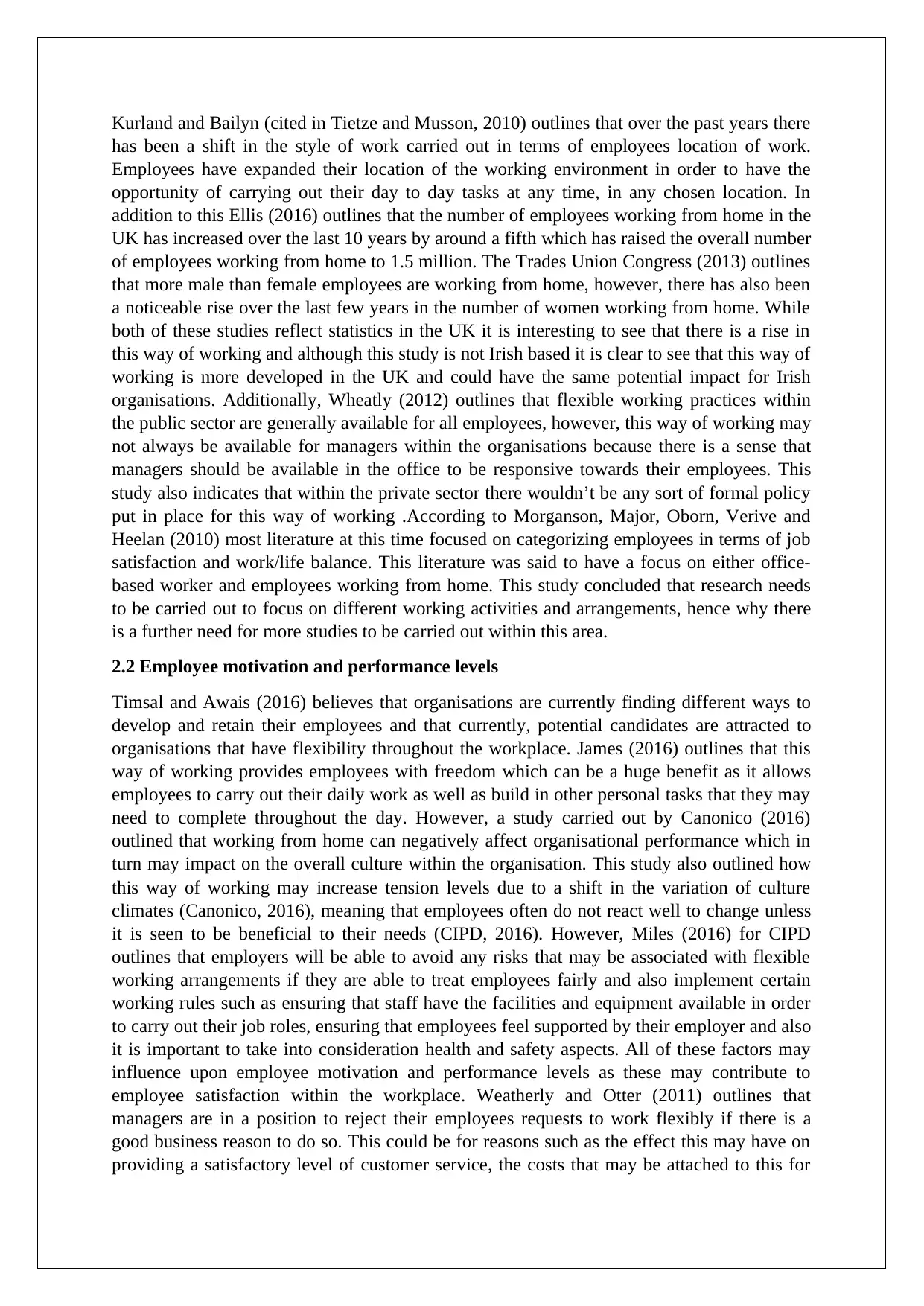
Kurland and Bailyn (cited in Tietze and Musson, 2010) outlines that over the past years there
has been a shift in the style of work carried out in terms of employees location of work.
Employees have expanded their location of the working environment in order to have the
opportunity of carrying out their day to day tasks at any time, in any chosen location. In
addition to this Ellis (2016) outlines that the number of employees working from home in the
UK has increased over the last 10 years by around a fifth which has raised the overall number
of employees working from home to 1.5 million. The Trades Union Congress (2013) outlines
that more male than female employees are working from home, however, there has also been
a noticeable rise over the last few years in the number of women working from home. While
both of these studies reflect statistics in the UK it is interesting to see that there is a rise in
this way of working and although this study is not Irish based it is clear to see that this way of
working is more developed in the UK and could have the same potential impact for Irish
organisations. Additionally, Wheatly (2012) outlines that flexible working practices within
the public sector are generally available for all employees, however, this way of working may
not always be available for managers within the organisations because there is a sense that
managers should be available in the office to be responsive towards their employees. This
study also indicates that within the private sector there wouldn’t be any sort of formal policy
put in place for this way of working .According to Morganson, Major, Oborn, Verive and
Heelan (2010) most literature at this time focused on categorizing employees in terms of job
satisfaction and work/life balance. This literature was said to have a focus on either office-
based worker and employees working from home. This study concluded that research needs
to be carried out to focus on different working activities and arrangements, hence why there
is a further need for more studies to be carried out within this area.
2.2 Employee motivation and performance levels
Timsal and Awais (2016) believes that organisations are currently finding different ways to
develop and retain their employees and that currently, potential candidates are attracted to
organisations that have flexibility throughout the workplace. James (2016) outlines that this
way of working provides employees with freedom which can be a huge benefit as it allows
employees to carry out their daily work as well as build in other personal tasks that they may
need to complete throughout the day. However, a study carried out by Canonico (2016)
outlined that working from home can negatively affect organisational performance which in
turn may impact on the overall culture within the organisation. This study also outlined how
this way of working may increase tension levels due to a shift in the variation of culture
climates (Canonico, 2016), meaning that employees often do not react well to change unless
it is seen to be beneficial to their needs (CIPD, 2016). However, Miles (2016) for CIPD
outlines that employers will be able to avoid any risks that may be associated with flexible
working arrangements if they are able to treat employees fairly and also implement certain
working rules such as ensuring that staff have the facilities and equipment available in order
to carry out their job roles, ensuring that employees feel supported by their employer and also
it is important to take into consideration health and safety aspects. All of these factors may
influence upon employee motivation and performance levels as these may contribute to
employee satisfaction within the workplace. Weatherly and Otter (2011) outlines that
managers are in a position to reject their employees requests to work flexibly if there is a
good business reason to do so. This could be for reasons such as the effect this may have on
providing a satisfactory level of customer service, the costs that may be attached to this for
has been a shift in the style of work carried out in terms of employees location of work.
Employees have expanded their location of the working environment in order to have the
opportunity of carrying out their day to day tasks at any time, in any chosen location. In
addition to this Ellis (2016) outlines that the number of employees working from home in the
UK has increased over the last 10 years by around a fifth which has raised the overall number
of employees working from home to 1.5 million. The Trades Union Congress (2013) outlines
that more male than female employees are working from home, however, there has also been
a noticeable rise over the last few years in the number of women working from home. While
both of these studies reflect statistics in the UK it is interesting to see that there is a rise in
this way of working and although this study is not Irish based it is clear to see that this way of
working is more developed in the UK and could have the same potential impact for Irish
organisations. Additionally, Wheatly (2012) outlines that flexible working practices within
the public sector are generally available for all employees, however, this way of working may
not always be available for managers within the organisations because there is a sense that
managers should be available in the office to be responsive towards their employees. This
study also indicates that within the private sector there wouldn’t be any sort of formal policy
put in place for this way of working .According to Morganson, Major, Oborn, Verive and
Heelan (2010) most literature at this time focused on categorizing employees in terms of job
satisfaction and work/life balance. This literature was said to have a focus on either office-
based worker and employees working from home. This study concluded that research needs
to be carried out to focus on different working activities and arrangements, hence why there
is a further need for more studies to be carried out within this area.
2.2 Employee motivation and performance levels
Timsal and Awais (2016) believes that organisations are currently finding different ways to
develop and retain their employees and that currently, potential candidates are attracted to
organisations that have flexibility throughout the workplace. James (2016) outlines that this
way of working provides employees with freedom which can be a huge benefit as it allows
employees to carry out their daily work as well as build in other personal tasks that they may
need to complete throughout the day. However, a study carried out by Canonico (2016)
outlined that working from home can negatively affect organisational performance which in
turn may impact on the overall culture within the organisation. This study also outlined how
this way of working may increase tension levels due to a shift in the variation of culture
climates (Canonico, 2016), meaning that employees often do not react well to change unless
it is seen to be beneficial to their needs (CIPD, 2016). However, Miles (2016) for CIPD
outlines that employers will be able to avoid any risks that may be associated with flexible
working arrangements if they are able to treat employees fairly and also implement certain
working rules such as ensuring that staff have the facilities and equipment available in order
to carry out their job roles, ensuring that employees feel supported by their employer and also
it is important to take into consideration health and safety aspects. All of these factors may
influence upon employee motivation and performance levels as these may contribute to
employee satisfaction within the workplace. Weatherly and Otter (2011) outlines that
managers are in a position to reject their employees requests to work flexibly if there is a
good business reason to do so. This could be for reasons such as the effect this may have on
providing a satisfactory level of customer service, the costs that may be attached to this for
⊘ This is a preview!⊘
Do you want full access?
Subscribe today to unlock all pages.

Trusted by 1+ million students worldwide
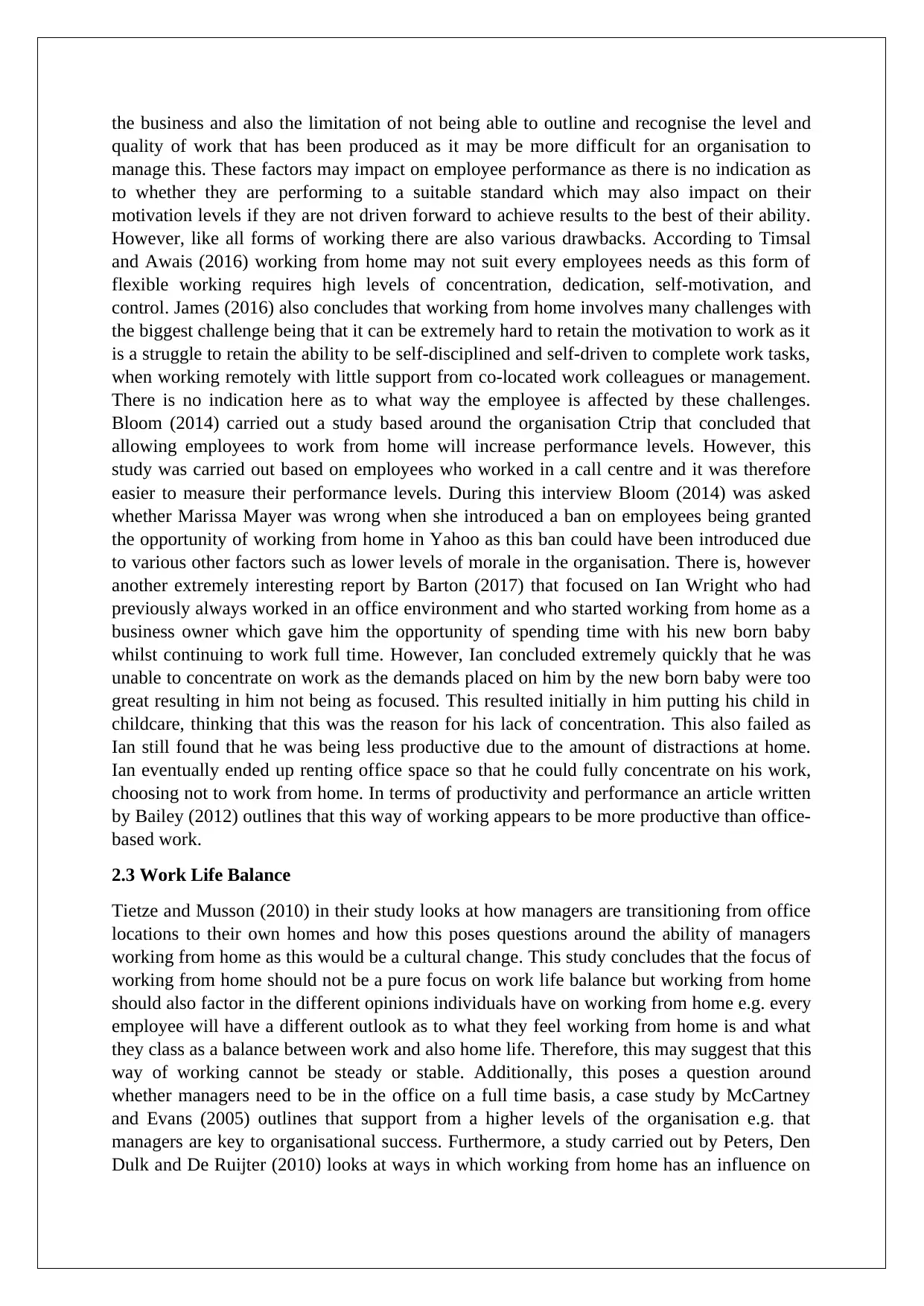
the business and also the limitation of not being able to outline and recognise the level and
quality of work that has been produced as it may be more difficult for an organisation to
manage this. These factors may impact on employee performance as there is no indication as
to whether they are performing to a suitable standard which may also impact on their
motivation levels if they are not driven forward to achieve results to the best of their ability.
However, like all forms of working there are also various drawbacks. According to Timsal
and Awais (2016) working from home may not suit every employees needs as this form of
flexible working requires high levels of concentration, dedication, self-motivation, and
control. James (2016) also concludes that working from home involves many challenges with
the biggest challenge being that it can be extremely hard to retain the motivation to work as it
is a struggle to retain the ability to be self-disciplined and self-driven to complete work tasks,
when working remotely with little support from co-located work colleagues or management.
There is no indication here as to what way the employee is affected by these challenges.
Bloom (2014) carried out a study based around the organisation Ctrip that concluded that
allowing employees to work from home will increase performance levels. However, this
study was carried out based on employees who worked in a call centre and it was therefore
easier to measure their performance levels. During this interview Bloom (2014) was asked
whether Marissa Mayer was wrong when she introduced a ban on employees being granted
the opportunity of working from home in Yahoo as this ban could have been introduced due
to various other factors such as lower levels of morale in the organisation. There is, however
another extremely interesting report by Barton (2017) that focused on Ian Wright who had
previously always worked in an office environment and who started working from home as a
business owner which gave him the opportunity of spending time with his new born baby
whilst continuing to work full time. However, Ian concluded extremely quickly that he was
unable to concentrate on work as the demands placed on him by the new born baby were too
great resulting in him not being as focused. This resulted initially in him putting his child in
childcare, thinking that this was the reason for his lack of concentration. This also failed as
Ian still found that he was being less productive due to the amount of distractions at home.
Ian eventually ended up renting office space so that he could fully concentrate on his work,
choosing not to work from home. In terms of productivity and performance an article written
by Bailey (2012) outlines that this way of working appears to be more productive than office-
based work.
2.3 Work Life Balance
Tietze and Musson (2010) in their study looks at how managers are transitioning from office
locations to their own homes and how this poses questions around the ability of managers
working from home as this would be a cultural change. This study concludes that the focus of
working from home should not be a pure focus on work life balance but working from home
should also factor in the different opinions individuals have on working from home e.g. every
employee will have a different outlook as to what they feel working from home is and what
they class as a balance between work and also home life. Therefore, this may suggest that this
way of working cannot be steady or stable. Additionally, this poses a question around
whether managers need to be in the office on a full time basis, a case study by McCartney
and Evans (2005) outlines that support from a higher levels of the organisation e.g. that
managers are key to organisational success. Furthermore, a study carried out by Peters, Den
Dulk and De Ruijter (2010) looks at ways in which working from home has an influence on
quality of work that has been produced as it may be more difficult for an organisation to
manage this. These factors may impact on employee performance as there is no indication as
to whether they are performing to a suitable standard which may also impact on their
motivation levels if they are not driven forward to achieve results to the best of their ability.
However, like all forms of working there are also various drawbacks. According to Timsal
and Awais (2016) working from home may not suit every employees needs as this form of
flexible working requires high levels of concentration, dedication, self-motivation, and
control. James (2016) also concludes that working from home involves many challenges with
the biggest challenge being that it can be extremely hard to retain the motivation to work as it
is a struggle to retain the ability to be self-disciplined and self-driven to complete work tasks,
when working remotely with little support from co-located work colleagues or management.
There is no indication here as to what way the employee is affected by these challenges.
Bloom (2014) carried out a study based around the organisation Ctrip that concluded that
allowing employees to work from home will increase performance levels. However, this
study was carried out based on employees who worked in a call centre and it was therefore
easier to measure their performance levels. During this interview Bloom (2014) was asked
whether Marissa Mayer was wrong when she introduced a ban on employees being granted
the opportunity of working from home in Yahoo as this ban could have been introduced due
to various other factors such as lower levels of morale in the organisation. There is, however
another extremely interesting report by Barton (2017) that focused on Ian Wright who had
previously always worked in an office environment and who started working from home as a
business owner which gave him the opportunity of spending time with his new born baby
whilst continuing to work full time. However, Ian concluded extremely quickly that he was
unable to concentrate on work as the demands placed on him by the new born baby were too
great resulting in him not being as focused. This resulted initially in him putting his child in
childcare, thinking that this was the reason for his lack of concentration. This also failed as
Ian still found that he was being less productive due to the amount of distractions at home.
Ian eventually ended up renting office space so that he could fully concentrate on his work,
choosing not to work from home. In terms of productivity and performance an article written
by Bailey (2012) outlines that this way of working appears to be more productive than office-
based work.
2.3 Work Life Balance
Tietze and Musson (2010) in their study looks at how managers are transitioning from office
locations to their own homes and how this poses questions around the ability of managers
working from home as this would be a cultural change. This study concludes that the focus of
working from home should not be a pure focus on work life balance but working from home
should also factor in the different opinions individuals have on working from home e.g. every
employee will have a different outlook as to what they feel working from home is and what
they class as a balance between work and also home life. Therefore, this may suggest that this
way of working cannot be steady or stable. Additionally, this poses a question around
whether managers need to be in the office on a full time basis, a case study by McCartney
and Evans (2005) outlines that support from a higher levels of the organisation e.g. that
managers are key to organisational success. Furthermore, a study carried out by Peters, Den
Dulk and De Ruijter (2010) looks at ways in which working from home has an influence on
Paraphrase This Document
Need a fresh take? Get an instant paraphrase of this document with our AI Paraphraser
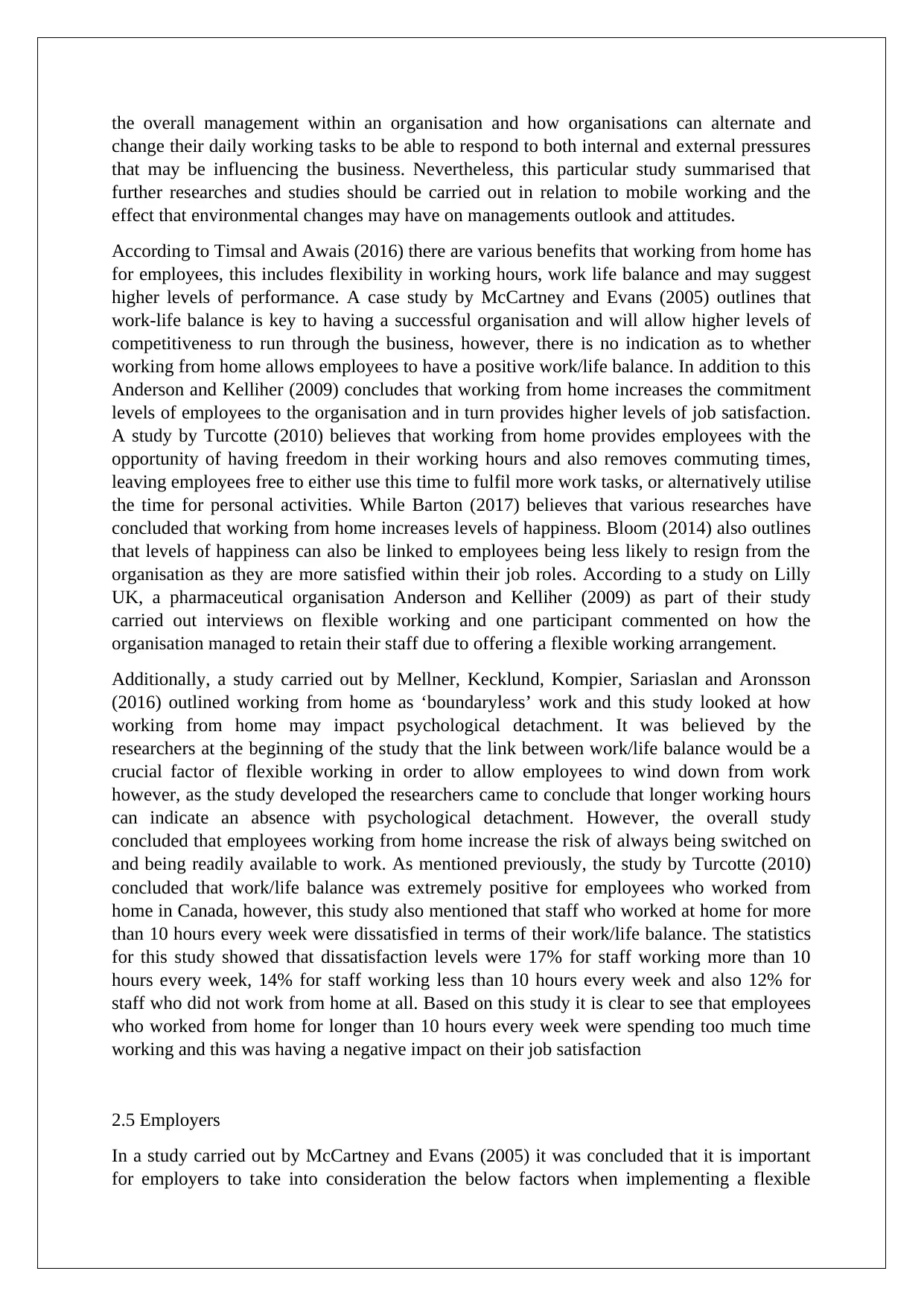
the overall management within an organisation and how organisations can alternate and
change their daily working tasks to be able to respond to both internal and external pressures
that may be influencing the business. Nevertheless, this particular study summarised that
further researches and studies should be carried out in relation to mobile working and the
effect that environmental changes may have on managements outlook and attitudes.
According to Timsal and Awais (2016) there are various benefits that working from home has
for employees, this includes flexibility in working hours, work life balance and may suggest
higher levels of performance. A case study by McCartney and Evans (2005) outlines that
work-life balance is key to having a successful organisation and will allow higher levels of
competitiveness to run through the business, however, there is no indication as to whether
working from home allows employees to have a positive work/life balance. In addition to this
Anderson and Kelliher (2009) concludes that working from home increases the commitment
levels of employees to the organisation and in turn provides higher levels of job satisfaction.
A study by Turcotte (2010) believes that working from home provides employees with the
opportunity of having freedom in their working hours and also removes commuting times,
leaving employees free to either use this time to fulfil more work tasks, or alternatively utilise
the time for personal activities. While Barton (2017) believes that various researches have
concluded that working from home increases levels of happiness. Bloom (2014) also outlines
that levels of happiness can also be linked to employees being less likely to resign from the
organisation as they are more satisfied within their job roles. According to a study on Lilly
UK, a pharmaceutical organisation Anderson and Kelliher (2009) as part of their study
carried out interviews on flexible working and one participant commented on how the
organisation managed to retain their staff due to offering a flexible working arrangement.
Additionally, a study carried out by Mellner, Kecklund, Kompier, Sariaslan and Aronsson
(2016) outlined working from home as ‘boundaryless’ work and this study looked at how
working from home may impact psychological detachment. It was believed by the
researchers at the beginning of the study that the link between work/life balance would be a
crucial factor of flexible working in order to allow employees to wind down from work
however, as the study developed the researchers came to conclude that longer working hours
can indicate an absence with psychological detachment. However, the overall study
concluded that employees working from home increase the risk of always being switched on
and being readily available to work. As mentioned previously, the study by Turcotte (2010)
concluded that work/life balance was extremely positive for employees who worked from
home in Canada, however, this study also mentioned that staff who worked at home for more
than 10 hours every week were dissatisfied in terms of their work/life balance. The statistics
for this study showed that dissatisfaction levels were 17% for staff working more than 10
hours every week, 14% for staff working less than 10 hours every week and also 12% for
staff who did not work from home at all. Based on this study it is clear to see that employees
who worked from home for longer than 10 hours every week were spending too much time
working and this was having a negative impact on their job satisfaction
2.5 Employers
In a study carried out by McCartney and Evans (2005) it was concluded that it is important
for employers to take into consideration the below factors when implementing a flexible
change their daily working tasks to be able to respond to both internal and external pressures
that may be influencing the business. Nevertheless, this particular study summarised that
further researches and studies should be carried out in relation to mobile working and the
effect that environmental changes may have on managements outlook and attitudes.
According to Timsal and Awais (2016) there are various benefits that working from home has
for employees, this includes flexibility in working hours, work life balance and may suggest
higher levels of performance. A case study by McCartney and Evans (2005) outlines that
work-life balance is key to having a successful organisation and will allow higher levels of
competitiveness to run through the business, however, there is no indication as to whether
working from home allows employees to have a positive work/life balance. In addition to this
Anderson and Kelliher (2009) concludes that working from home increases the commitment
levels of employees to the organisation and in turn provides higher levels of job satisfaction.
A study by Turcotte (2010) believes that working from home provides employees with the
opportunity of having freedom in their working hours and also removes commuting times,
leaving employees free to either use this time to fulfil more work tasks, or alternatively utilise
the time for personal activities. While Barton (2017) believes that various researches have
concluded that working from home increases levels of happiness. Bloom (2014) also outlines
that levels of happiness can also be linked to employees being less likely to resign from the
organisation as they are more satisfied within their job roles. According to a study on Lilly
UK, a pharmaceutical organisation Anderson and Kelliher (2009) as part of their study
carried out interviews on flexible working and one participant commented on how the
organisation managed to retain their staff due to offering a flexible working arrangement.
Additionally, a study carried out by Mellner, Kecklund, Kompier, Sariaslan and Aronsson
(2016) outlined working from home as ‘boundaryless’ work and this study looked at how
working from home may impact psychological detachment. It was believed by the
researchers at the beginning of the study that the link between work/life balance would be a
crucial factor of flexible working in order to allow employees to wind down from work
however, as the study developed the researchers came to conclude that longer working hours
can indicate an absence with psychological detachment. However, the overall study
concluded that employees working from home increase the risk of always being switched on
and being readily available to work. As mentioned previously, the study by Turcotte (2010)
concluded that work/life balance was extremely positive for employees who worked from
home in Canada, however, this study also mentioned that staff who worked at home for more
than 10 hours every week were dissatisfied in terms of their work/life balance. The statistics
for this study showed that dissatisfaction levels were 17% for staff working more than 10
hours every week, 14% for staff working less than 10 hours every week and also 12% for
staff who did not work from home at all. Based on this study it is clear to see that employees
who worked from home for longer than 10 hours every week were spending too much time
working and this was having a negative impact on their job satisfaction
2.5 Employers
In a study carried out by McCartney and Evans (2005) it was concluded that it is important
for employers to take into consideration the below factors when implementing a flexible
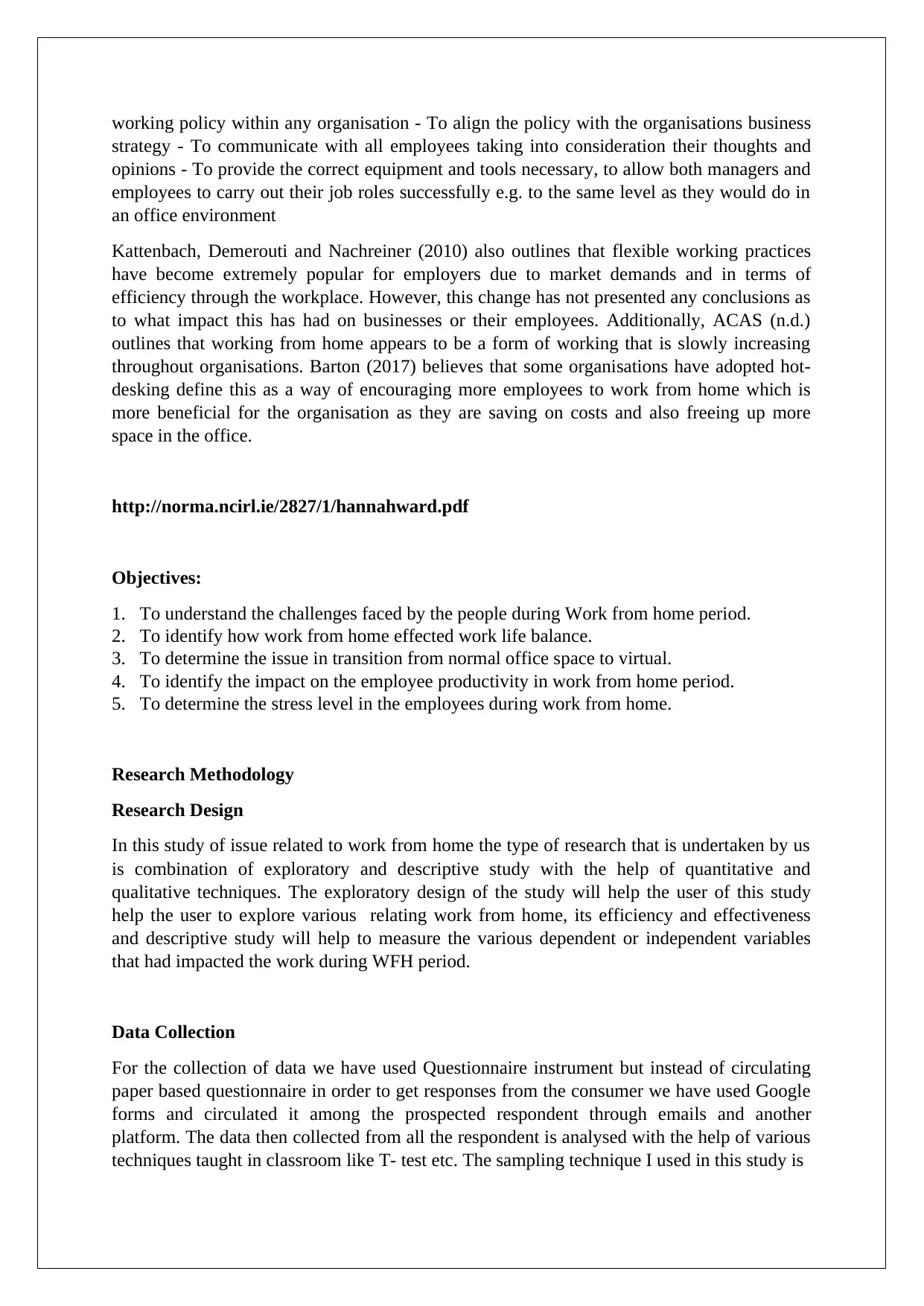
working policy within any organisation - To align the policy with the organisations business
strategy - To communicate with all employees taking into consideration their thoughts and
opinions - To provide the correct equipment and tools necessary, to allow both managers and
employees to carry out their job roles successfully e.g. to the same level as they would do in
an office environment
Kattenbach, Demerouti and Nachreiner (2010) also outlines that flexible working practices
have become extremely popular for employers due to market demands and in terms of
efficiency through the workplace. However, this change has not presented any conclusions as
to what impact this has had on businesses or their employees. Additionally, ACAS (n.d.)
outlines that working from home appears to be a form of working that is slowly increasing
throughout organisations. Barton (2017) believes that some organisations have adopted hot-
desking define this as a way of encouraging more employees to work from home which is
more beneficial for the organisation as they are saving on costs and also freeing up more
space in the office.
http://norma.ncirl.ie/2827/1/hannahward.pdf
Objectives:
1. To understand the challenges faced by the people during Work from home period.
2. To identify how work from home effected work life balance.
3. To determine the issue in transition from normal office space to virtual.
4. To identify the impact on the employee productivity in work from home period.
5. To determine the stress level in the employees during work from home.
Research Methodology
Research Design
In this study of issue related to work from home the type of research that is undertaken by us
is combination of exploratory and descriptive study with the help of quantitative and
qualitative techniques. The exploratory design of the study will help the user of this study
help the user to explore various relating work from home, its efficiency and effectiveness
and descriptive study will help to measure the various dependent or independent variables
that had impacted the work during WFH period.
Data Collection
For the collection of data we have used Questionnaire instrument but instead of circulating
paper based questionnaire in order to get responses from the consumer we have used Google
forms and circulated it among the prospected respondent through emails and another
platform. The data then collected from all the respondent is analysed with the help of various
techniques taught in classroom like T- test etc. The sampling technique I used in this study is
strategy - To communicate with all employees taking into consideration their thoughts and
opinions - To provide the correct equipment and tools necessary, to allow both managers and
employees to carry out their job roles successfully e.g. to the same level as they would do in
an office environment
Kattenbach, Demerouti and Nachreiner (2010) also outlines that flexible working practices
have become extremely popular for employers due to market demands and in terms of
efficiency through the workplace. However, this change has not presented any conclusions as
to what impact this has had on businesses or their employees. Additionally, ACAS (n.d.)
outlines that working from home appears to be a form of working that is slowly increasing
throughout organisations. Barton (2017) believes that some organisations have adopted hot-
desking define this as a way of encouraging more employees to work from home which is
more beneficial for the organisation as they are saving on costs and also freeing up more
space in the office.
http://norma.ncirl.ie/2827/1/hannahward.pdf
Objectives:
1. To understand the challenges faced by the people during Work from home period.
2. To identify how work from home effected work life balance.
3. To determine the issue in transition from normal office space to virtual.
4. To identify the impact on the employee productivity in work from home period.
5. To determine the stress level in the employees during work from home.
Research Methodology
Research Design
In this study of issue related to work from home the type of research that is undertaken by us
is combination of exploratory and descriptive study with the help of quantitative and
qualitative techniques. The exploratory design of the study will help the user of this study
help the user to explore various relating work from home, its efficiency and effectiveness
and descriptive study will help to measure the various dependent or independent variables
that had impacted the work during WFH period.
Data Collection
For the collection of data we have used Questionnaire instrument but instead of circulating
paper based questionnaire in order to get responses from the consumer we have used Google
forms and circulated it among the prospected respondent through emails and another
platform. The data then collected from all the respondent is analysed with the help of various
techniques taught in classroom like T- test etc. The sampling technique I used in this study is
⊘ This is a preview!⊘
Do you want full access?
Subscribe today to unlock all pages.

Trusted by 1+ million students worldwide
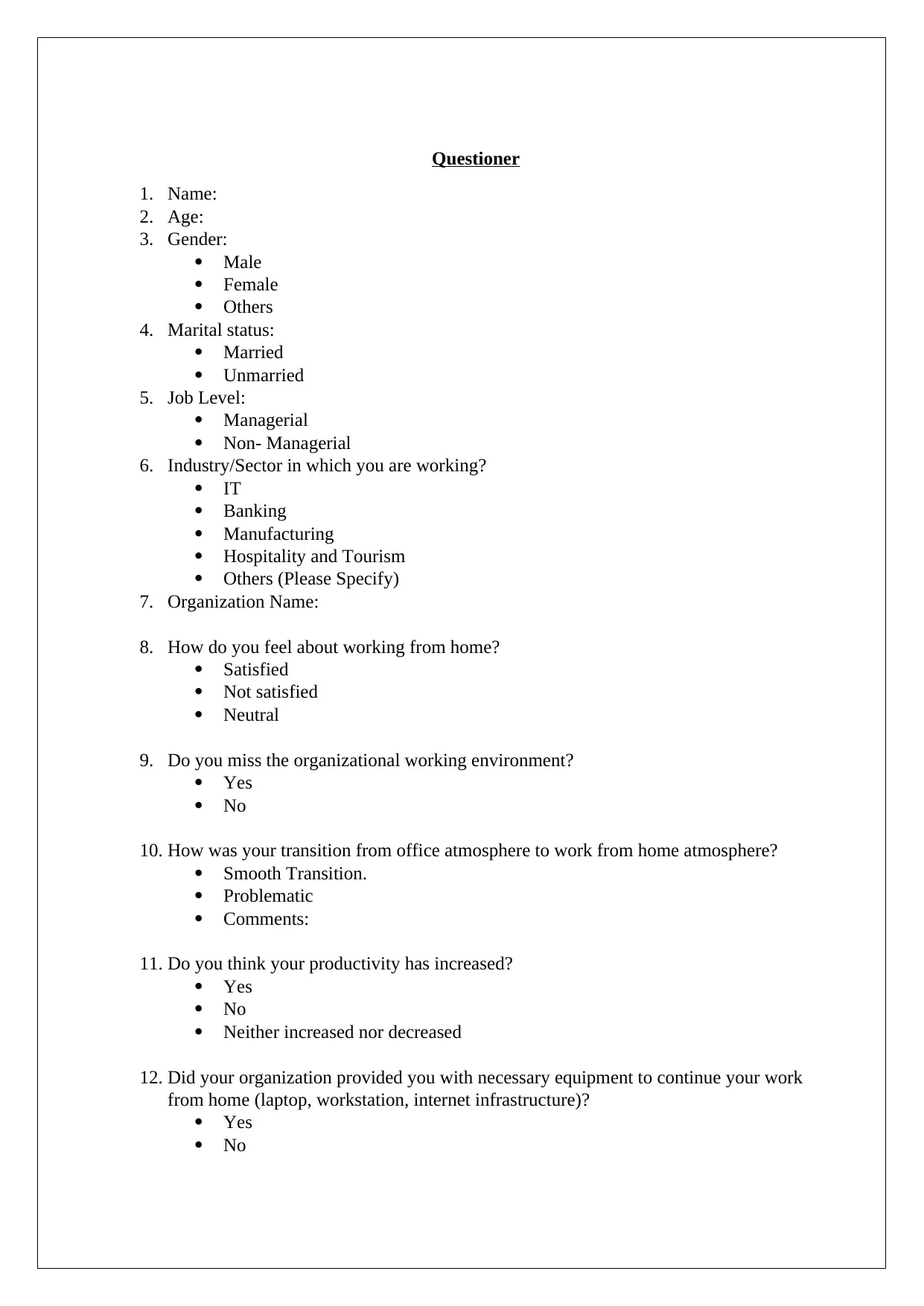
Questioner
1. Name:
2. Age:
3. Gender:
Male
Female
Others
4. Marital status:
Married
Unmarried
5. Job Level:
Managerial
Non- Managerial
6. Industry/Sector in which you are working?
IT
Banking
Manufacturing
Hospitality and Tourism
Others (Please Specify)
7. Organization Name:
8. How do you feel about working from home?
Satisfied
Not satisfied
Neutral
9. Do you miss the organizational working environment?
Yes
No
10. How was your transition from office atmosphere to work from home atmosphere?
Smooth Transition.
Problematic
Comments:
11. Do you think your productivity has increased?
Yes
No
Neither increased nor decreased
12. Did your organization provided you with necessary equipment to continue your work
from home (laptop, workstation, internet infrastructure)?
Yes
No
1. Name:
2. Age:
3. Gender:
Male
Female
Others
4. Marital status:
Married
Unmarried
5. Job Level:
Managerial
Non- Managerial
6. Industry/Sector in which you are working?
IT
Banking
Manufacturing
Hospitality and Tourism
Others (Please Specify)
7. Organization Name:
8. How do you feel about working from home?
Satisfied
Not satisfied
Neutral
9. Do you miss the organizational working environment?
Yes
No
10. How was your transition from office atmosphere to work from home atmosphere?
Smooth Transition.
Problematic
Comments:
11. Do you think your productivity has increased?
Yes
No
Neither increased nor decreased
12. Did your organization provided you with necessary equipment to continue your work
from home (laptop, workstation, internet infrastructure)?
Yes
No
Paraphrase This Document
Need a fresh take? Get an instant paraphrase of this document with our AI Paraphraser
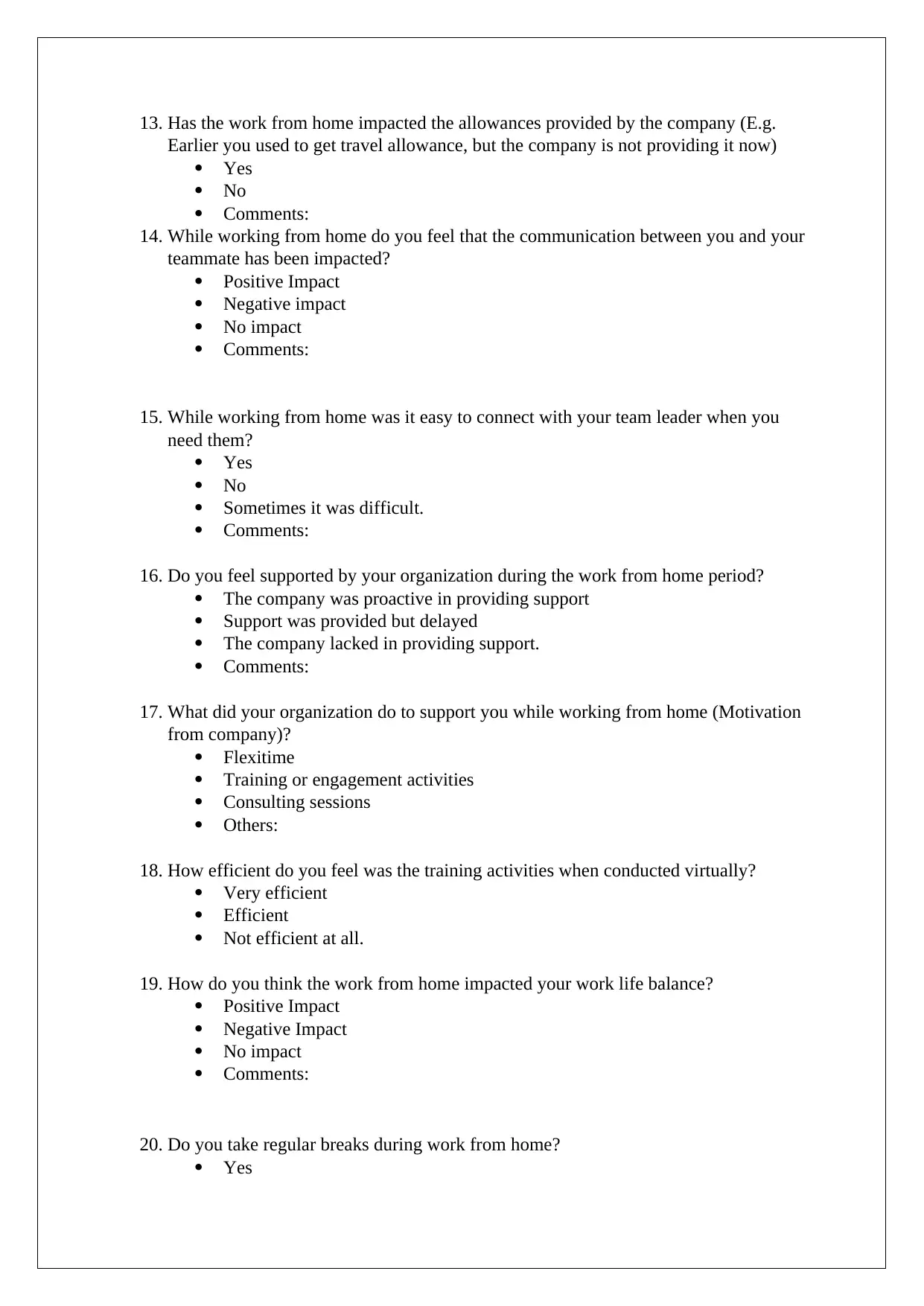
13. Has the work from home impacted the allowances provided by the company (E.g.
Earlier you used to get travel allowance, but the company is not providing it now)
Yes
No
Comments:
14. While working from home do you feel that the communication between you and your
teammate has been impacted?
Positive Impact
Negative impact
No impact
Comments:
15. While working from home was it easy to connect with your team leader when you
need them?
Yes
No
Sometimes it was difficult.
Comments:
16. Do you feel supported by your organization during the work from home period?
The company was proactive in providing support
Support was provided but delayed
The company lacked in providing support.
Comments:
17. What did your organization do to support you while working from home (Motivation
from company)?
Flexitime
Training or engagement activities
Consulting sessions
Others:
18. How efficient do you feel was the training activities when conducted virtually?
Very efficient
Efficient
Not efficient at all.
19. How do you think the work from home impacted your work life balance?
Positive Impact
Negative Impact
No impact
Comments:
20. Do you take regular breaks during work from home?
Yes
Earlier you used to get travel allowance, but the company is not providing it now)
Yes
No
Comments:
14. While working from home do you feel that the communication between you and your
teammate has been impacted?
Positive Impact
Negative impact
No impact
Comments:
15. While working from home was it easy to connect with your team leader when you
need them?
Yes
No
Sometimes it was difficult.
Comments:
16. Do you feel supported by your organization during the work from home period?
The company was proactive in providing support
Support was provided but delayed
The company lacked in providing support.
Comments:
17. What did your organization do to support you while working from home (Motivation
from company)?
Flexitime
Training or engagement activities
Consulting sessions
Others:
18. How efficient do you feel was the training activities when conducted virtually?
Very efficient
Efficient
Not efficient at all.
19. How do you think the work from home impacted your work life balance?
Positive Impact
Negative Impact
No impact
Comments:
20. Do you take regular breaks during work from home?
Yes
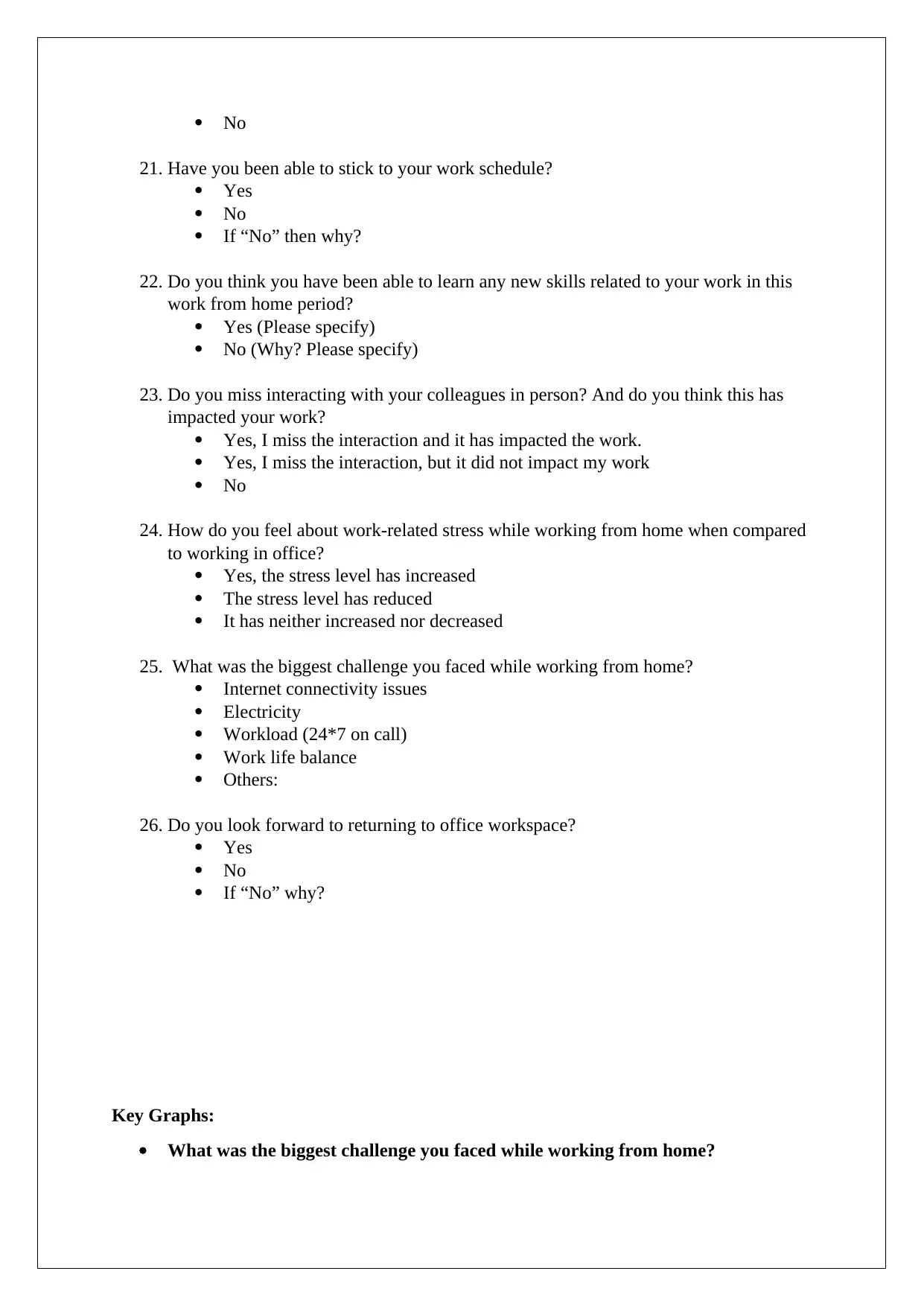
No
21. Have you been able to stick to your work schedule?
Yes
No
If “No” then why?
22. Do you think you have been able to learn any new skills related to your work in this
work from home period?
Yes (Please specify)
No (Why? Please specify)
23. Do you miss interacting with your colleagues in person? And do you think this has
impacted your work?
Yes, I miss the interaction and it has impacted the work.
Yes, I miss the interaction, but it did not impact my work
No
24. How do you feel about work-related stress while working from home when compared
to working in office?
Yes, the stress level has increased
The stress level has reduced
It has neither increased nor decreased
25. What was the biggest challenge you faced while working from home?
Internet connectivity issues
Electricity
Workload (24*7 on call)
Work life balance
Others:
26. Do you look forward to returning to office workspace?
Yes
No
If “No” why?
Key Graphs:
What was the biggest challenge you faced while working from home?
21. Have you been able to stick to your work schedule?
Yes
No
If “No” then why?
22. Do you think you have been able to learn any new skills related to your work in this
work from home period?
Yes (Please specify)
No (Why? Please specify)
23. Do you miss interacting with your colleagues in person? And do you think this has
impacted your work?
Yes, I miss the interaction and it has impacted the work.
Yes, I miss the interaction, but it did not impact my work
No
24. How do you feel about work-related stress while working from home when compared
to working in office?
Yes, the stress level has increased
The stress level has reduced
It has neither increased nor decreased
25. What was the biggest challenge you faced while working from home?
Internet connectivity issues
Electricity
Workload (24*7 on call)
Work life balance
Others:
26. Do you look forward to returning to office workspace?
Yes
No
If “No” why?
Key Graphs:
What was the biggest challenge you faced while working from home?
⊘ This is a preview!⊘
Do you want full access?
Subscribe today to unlock all pages.

Trusted by 1+ million students worldwide
1 out of 18
Your All-in-One AI-Powered Toolkit for Academic Success.
+13062052269
info@desklib.com
Available 24*7 on WhatsApp / Email
![[object Object]](/_next/static/media/star-bottom.7253800d.svg)
Unlock your academic potential
Copyright © 2020–2025 A2Z Services. All Rights Reserved. Developed and managed by ZUCOL.

